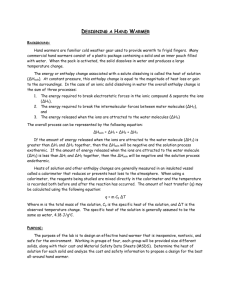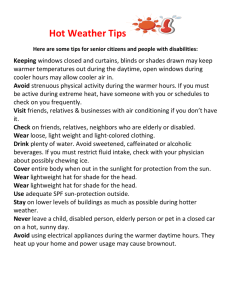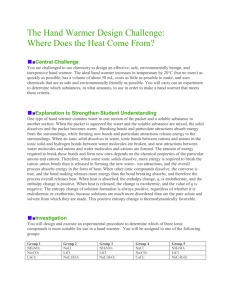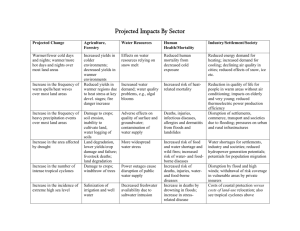Hand Warmer Design Challenge: Chemistry Lab Experiment
advertisement
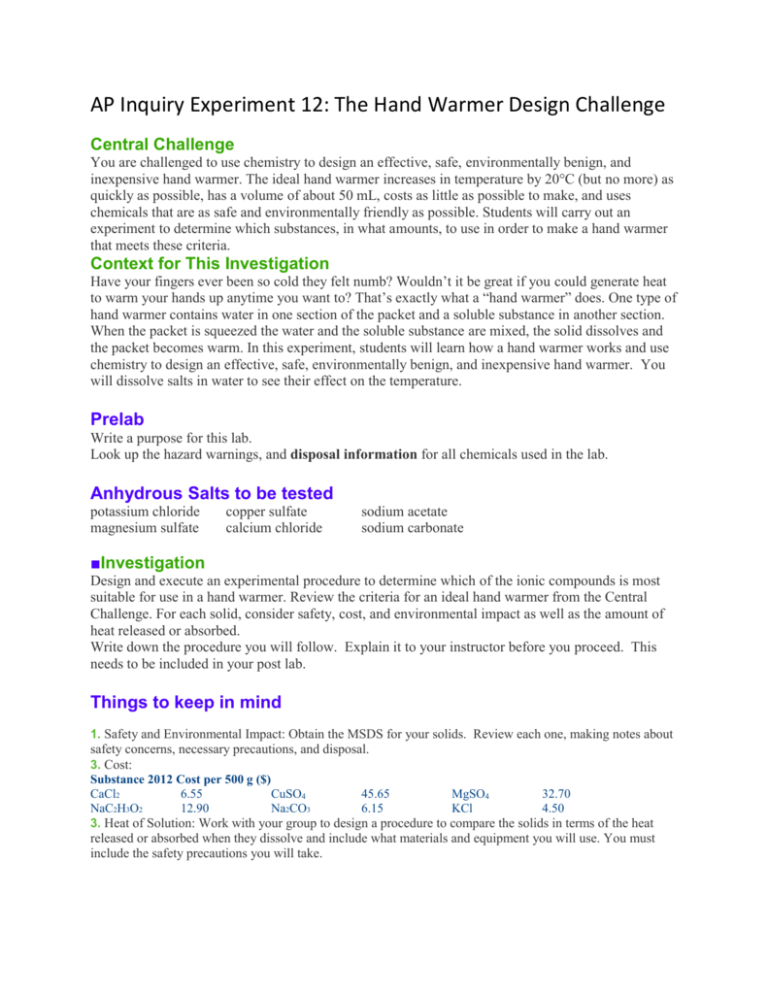
AP Inquiry Experiment 12: The Hand Warmer Design Challenge Central Challenge You are challenged to use chemistry to design an effective, safe, environmentally benign, and inexpensive hand warmer. The ideal hand warmer increases in temperature by 20°C (but no more) as quickly as possible, has a volume of about 50 mL, costs as little as possible to make, and uses chemicals that are as safe and environmentally friendly as possible. Students will carry out an experiment to determine which substances, in what amounts, to use in order to make a hand warmer that meets these criteria. Context for This Investigation Have your fingers ever been so cold they felt numb? Wouldn’t it be great if you could generate heat to warm your hands up anytime you want to? That’s exactly what a “hand warmer” does. One type of hand warmer contains water in one section of the packet and a soluble substance in another section. When the packet is squeezed the water and the soluble substance are mixed, the solid dissolves and the packet becomes warm. In this experiment, students will learn how a hand warmer works and use chemistry to design an effective, safe, environmentally benign, and inexpensive hand warmer. You will dissolve salts in water to see their effect on the temperature. Prelab Write a purpose for this lab. Look up the hazard warnings, and disposal information for all chemicals used in the lab. Anhydrous Salts to be tested potassium chloride magnesium sulfate copper sulfate calcium chloride sodium acetate sodium carbonate ■Investigation Design and execute an experimental procedure to determine which of the ionic compounds is most suitable for use in a hand warmer. Review the criteria for an ideal hand warmer from the Central Challenge. For each solid, consider safety, cost, and environmental impact as well as the amount of heat released or absorbed. Write down the procedure you will follow. Explain it to your instructor before you proceed. This needs to be included in your post lab. Things to keep in mind 1. Safety and Environmental Impact: Obtain the MSDS for your solids. Review each one, making notes about safety concerns, necessary precautions, and disposal. 3. Cost: Substance 2012 Cost per 500 g ($) CaCl2 6.55 CuSO4 45.65 MgSO4 32.70 NaC2H3O2 12.90 Na2CO3 6.15 KCl 4.50 3. Heat of Solution: Work with your group to design a procedure to compare the solids in terms of the heat released or absorbed when they dissolve and include what materials and equipment you will use. You must include the safety precautions you will take. Important Procedural Tips 1. Be sure to keep detailed records of the amounts of substances used and the starting and ending temperature as you will need it later to determine the amount of solid to use in your hand warmer. 2. You will receive a maximum of 10 g of each solid for this part. 3. Use a Styrofoam cup as a colorimeter, otherwise you will lose a lot of heat. Nest the Styrofoam cup in a beaker, it will tip over if you don’t. Keeping a lid on the cup will give you better results. Data Collection and Computation You now need to calculate the change of enthalpy of dissolution (also called the “heat of solution,” with symbol ΔHsoln, and units of kJ/mol solute) occurring in aqueous solution. The data necessary to calculate the heat of solution can be obtained using a calorimeter. Calorimeter Constant Determination: According to the law of conservation of energy, energy cannot be created or destroyed, only changed from one form to another or transferred from one system to another. The temperature change observed when water or any substance changes temperature can be a result of a transfer of energy from the substance to the surroundings (in which case the temperature of the substance decreases) or the surroundings to the substance (in which case the temperature of the substance increases). When hot and cold water are mixed, the hot water transfers some of its thermal energy to the cool water. The law of conservation of energy dictates that the amount of thermal energy lost (or the enthalpy change) by the hot water, qhot, is equal to the enthalpy change of the cool water, qcold, but opposite in sign, so qhot = –qcold. The enthalpy change for any substance is directly related to the mass of substance, m; the specific heat capacity (a substance-specific constant), c; and the temperature change, ΔT. The relationship is expressed mathematically in the equation q = mcΔT. The specific heat capacity of water is 4.184 J/oC°•g. Post Lab Write down the procedure you followed including all data you collected at each point. Answer the following questions. 1. Calculate the temperature change per gram of each salt. Determine the amount of salt needed to create a 20o temperature change, and the cost. 2. Calculate the enthalpy change of the water for each salt using the equation qhot = mcΔT. Assume that the density of water is exactly 1 g/mL. Is this an endothermic or exothermic process? Explain. 3. By convention, scientists report enthalpy changes for dissolution (and many other processes) in units of kilojoules per mole of solute dissolved. Using your values of qsoln, calculate the enthalpy in units of kilojoules per mole. This quantity has the symbol ΔHsoln. 4. Based on the cost information provided, and your experimental work and calculations, select which chemical you believe will make the most cost-effective hand warmer. The hand warmer you are designing needs to increase in temperature by 20°C. Calculate the amount of the compound you selected that would be required for a hand warmer that meets this requirement.




